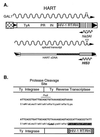Hybrid Ty1/HIV-1 elements used to detect inhibitors and monitor the activity of HIV-1 reverse transcriptase
- PMID: 9811899
- PMCID: PMC24958
- DOI: 10.1073/pnas.95.23.13905
Hybrid Ty1/HIV-1 elements used to detect inhibitors and monitor the activity of HIV-1 reverse transcriptase
Abstract
We previously demonstrated that hybrid retrotransposons composed of the yeast Ty1 element and the reverse transcriptase (RT) of HIV-1 are active in the yeast Saccharomyces cerevisiae. The RT activity of these hybrid Ty1/HIV-1 (his3AI/AIDS RT; HART) elements can be monitored by using a simple genetic assay. HART element reverse transcription depends on both the polymerase and RNase H domains of HIV-1 RT. Here we demonstrate that the HART assay is sensitive to inhibitors of HIV-1 RT. (-)-(S)-8-Chloro-4,5,6, 7-tetrahydro-5-methyl-6-(3-methyl-2-butenyl)imidazo[4,5,1-jk][1, 4]-benzodiazepin-2(1H)-thione monohydrochloride (8 Cl-TIBO), a well characterized non-nucleoside RT inhibitor (NNRTI) of HIV-1 RT, blocks propagation of HART elements. HART elements that express NNRTI-resistant RT variants of HIV-1 are insensitive to 8 Cl-TIBO, demonstrating the specificity of inhibition in this assay. HART elements carrying NNRTI-resistant variants of HIV-1 RT can be used to identify compounds that are active against drug-resistant viruses.
Figures



References
Publication types
MeSH terms
Substances
LinkOut - more resources
Full Text Sources
Other Literature Sources

